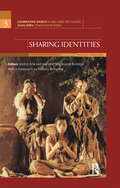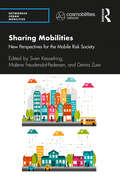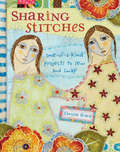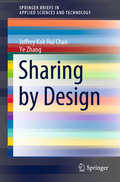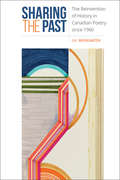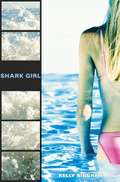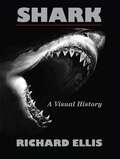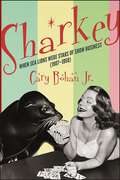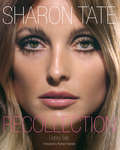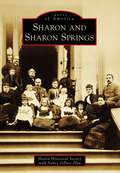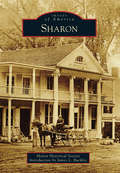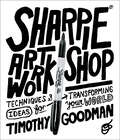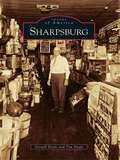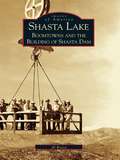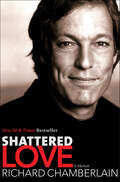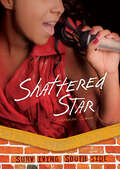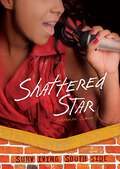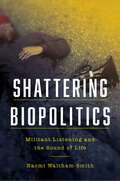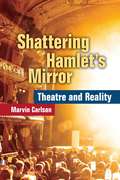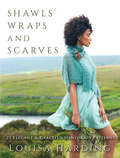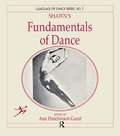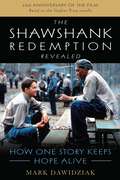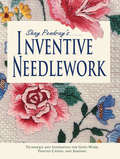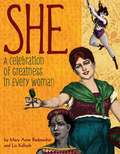- Table View
- List View
Sharing Identities: Celebrating Dance in Malaysia (Celebrating Dance In Asia And The Pacific Ser.)
by Mohd Anis Md NorThis anthology celebrates dancing diversities in Malaysia, a multicultural nation with old and not-so-old dance traditions in a synchronicity of history, creativity, inventions and representation of its people, culture and traditions. These articles and interviews document the legacy of dances from the Malay Sultanates to a contemporary remix of old and new dances aspired by a mélange of influences from the old world of India, China, European and indigenous dance traditions. This gives forth dance cultures that vibrate with multicultural dance experiences. Narratives of eclecticism, syncretic and innovative dance forms and styles reflect the processes of inventing and sharing of dance identities from the era of the colonial Malay states to post-independence Malaysia.
Sharing Mobilities: New Perspectives for the Mobile Risk Society (Networked Urban Mobilities Series)
by Dennis Zuev Sven Kesselring Malene Freudendal-PedersenSharing Mobilities focuses on the emergence of future sustainable and collaborative mobility cultures. At the intersection of physical and virtual capacity and access to people, goods, ideas, and services, this book poses fundamental challenges and opportunities for governance, economy, planning, and identity. The future of new collaborative forms of consumption and sharing would play a key role in the organization of everyday life and business. Sharing mobilities is more than simply sharing transport, and its diverse impacts on society and the environment demand thorough theory-led sociological research. With an extensive global range, the contributors present radical manifestations of sharing capacities throughout diverse countries, including Germany, Denmark, Japan, and Vietnam. The phenomenon of mobility is highly actual and social as well as politically relevant and urging. This collection focuses on open questions from the perspective of the mobilities turn while presenting state-of-the-art theory-based articles with applied perspectives. An ideal read for scholars based in social science and the interdisciplinary research on mobility, transports, and sharing economy. Sociologists, geographers, economists, urban governance researchers, and research students would also find this book of interest.
Sharing Stitches: Exchanging Fabric and Inspiration to Sew One-of-a-Kind Projects
by Chrissie GraceSwap, Stitch and Share Exchange fabrics, collaborate on an art quilt and gain inspiration with Sharing Stitches. Chrissie Grace is joined by 15 contributing artists with a wide variety of talents and styles. The result is a collection of colorful and eclectic projects, from a patchwork pullover and a lace-embellished headband to a large-scale collaborative art quilt and a round robin journal. Stitch by stitch, Chrissie shows you how create fantastic projects that are as unique as the group that sews them. Inside Sharing Stitches, you'll find: 22 step-by-step projects designed specifically for swaps and collaborations Tips on swapping fabric, hosting and participating in collaborations, and making sure sewing groups run smoothly Projects and gallery pieces from your favorite artists, including Claudine Hellmuth, Liz Lamoreux, Ruth Rae and more! Break out your sewing machine, round up your friends and start sewing!
Sharing by Design (SpringerBriefs in Applied Sciences and Technology)
by Jeffrey Kok Chan Ye ZhangThis book answers the question of how to design a sharing system that can promote sustained, meaningful, and socially constructive sharing practices in today’s cities. To do so, it constructs a framework for practical inquiry into the design of sharing systems. Further, the book invites readers to consider questions such as: If sharing can be designed, then how does one design a sharing system for cities? Which urban conditions make this sharing system possible? What are the considerations, variables, and methods that can inform and guide the designers of a sharing system? By considering both the environmental and societal motivations for sharing, and the reality that most examples of the Sharing Economy are neither equitable in their socio-economic outcomes nor genuine in their original social promises, this book presents balanced and thoughtful answers to the questions posed above. The book will appeal to a broad readership, from students and teachers in the various design disciplines, to professionals and scholars in architecture and urbanism, business and innovation, and other related fields of the humanities and social sciences, as well as activists and policymakers committed to achieving more sustainable and equitably distributed access to urban resources.
Sharing the Past: The Reinvention of History in Canadian Poetry since 1960
by J.A. WeingartenSharing the Past is an unprecedentedly detailed account of the intertwining discourses of Canadian history and creative literature. When social history emerged as its own field of study in the 1960s, it promised new stories that would bring readers away from the elite writing of academics and closer to the everyday experiences of people. Yet, the academy’s continued emphasis on professional distance and objectivity made it difficult for historians to connect with the experiences of those about whom they wrote, and those same emphases made it all but impossible for non-academic experts to be institutionally recognized as historians. Drawing on interviews and new archival materials to construct a history of Canadian poetry written since 1960, Sharing the Past argues that the project of social history has achieved its fullest expression in lyric poetry, a genre in which personal experiences anchor history. Developing this genre since 1960, Canadian poets have provided an inclusive model for a truly social history that indiscriminately shares the right to speak authoritatively of the past.
Shark Girl
by Kelly BinghamA teenager struggles through physical loss to the start of acceptance in an absorbing, artful novel at once honest and insightful, wrenching and redemptive. On a sunny day in June, at the beach with her mom and brother, fifteen-year-old Jane Arrowood went for a swim. And then everything--absolutely everything--changed. Now she's counting down the days until she returns to school with her fake arm, where she knows kids will whisper, "That's her--that's Shark Girl," as she passes. In the meantime there are only questions: Why did this happen? Why her? What about her art? What about her life? In this striking first novel, Kelly Bingham uses poems, letters, telephone conversations, and newspaper clippings to look unflinchingly at what it's like to lose part of yourself - and to summon the courage it takes to find yourself again.
Shark: A Visual History
by Richard Ellis“The sharks, ancient or modern, real or imaginary, have always been with us, and will probably remain with us forever. They appear not only in movies and literature, but in countless permutations of size, shape, and materials, permeating our daily lives with their silent menace. In a sense, humans live in a world replete with sharks, not vice-versa.” Thus Richard Ellis sets about chronicling and debunking the myths of sharks throughout history. From 18th century art to the phenomena of JAWS, “the shark” has remained the indomitable aggressor of the deep, the last demon of humankind. The image of the shark and the fear it inspires infiltrates our daily lives with its mythical power and strength. But it is not man who should fear the shark. Our need to dominate these predators is destroying them and their habitat. Through hundreds of full-color images Ellis proves the necessity of preserving these majestic creatures. As curator of the Ft. Lauderdale Museum of Art’s exhibition entitled “Shark”, debuting May 2012, Ellis adeptly turns these sleek, efficient hunters from monsters of the deep into rare, beautiful forces of nature.
Sharkey: When Sea Lions Were Stars of Show Business (1907-1958) (Excelsior Editions)
by Gary BohanGold Winner for the 2022 Foreword INDIES Book of the Year Award in the Performing Arts & Music Category"Sharkey is the natural artist, performing his magic for nothing but love." — Wolcott Gibbs, the New YorkerSharkey tells the compelling story of an unusually gifted, trained sea lion who shared the stage with practically every important performer of the first half of the twentieth century—from Bob Hope to Ella Fitzgerald, from Broadway to Hollywood and beyond. Readers follow Sharkey and his flippered colleagues as they travel the world with stops at the Ringling Bros. and Barnum & Bailey Circus, vaudeville houses, Manhattan during the Harlem Renaissance, burlesque nightclubs, movie palaces, Radio City Music Hall, and the legendary studios of early radio, movies, and television, meeting a who's who of showbiz entertainers, sports superstars, and even a US president. Meticulously researched and lavishly illustrated, Sharkey is a quirky slice of New York and entertainment history sure to delight fans of vintage pop culture and Americana, as well as animal lovers.
Sharon Tate: Recollection
by Debra Tate Roman PolanskiConsidered by many to be the most beautiful woman of her generation, Sharon Tate remains a fascinating pop icon and a poster child for the 1960s. What most struck those who knew Sharon was her gentle nature and the sheer perfection of her face, but she was far more than just a beauty. The few films she made during her brief career, including Valley of the Dolls, Eye of the Devil, and The Fearless Vampire Killers, have taken on a cult status. Over forty years since her last film, Sharon's spirit and charisma lives strong in the memories of those who knew her best, and her style continues to inspire the worlds of fashion, beauty, art, and film.Sharon Tate: Recollection is a one-of-a-kind celebration of Sharon's life and career, her influence as a fashion icon throughout the world, and in effect presents a sociological portrait of the 1960s-its youth culture, the sexual revolution, Hollywood's changing studio system, and the rise of independent cinema. In this dazzling photo book, Sharon Tate's story emerges through quotes and short essays-recollections-by her sister, Debra Tate, as well as by those who knew and who have been influenced by her. An all-star cast contributing memories and thoughts on Sharon includes Jack Nicholson, Warren Beatty, Robert Evans, Mia Farrow, Raquel Welch, Hugh Hefner, Michelle Phillips, Patty Duke, Barbara Parkins, Jane Fonda, Drew Barrymore, and Kelly Osbourne. The book is filled with hundreds of rare and unpublished photos of Sharon Tate taken by the likes of Milton Greene, David Bailey, Terry O'Neill, Richard Avedon, Bert Stern, Norman Parkinson, Philippe Halsman, John Engstead, and more.What emerges from these pages is a stunning tribute to an unforgettable life.
Sharon and Sharon Springs
by Sharon Historical Society Nancy Dipace PfauLocated in the northwest corner of Schoharie County, Sharon was established in 1797 after Palatine German and Dutch families had settled in the area, replacing the Iroquois in the 18th century. Set in rolling hills with magnificent vistas over the Mohawk Valley, the area's mineral springs drew native people and Europeans to bathe in the health-promoting waters. The spa era of grand hotels and wealthy guests gave way to a slow but steady decline around 1900; however, from the early 1990s, the town has enjoyed a renaissance with the arrival of creative artists and entrepreneurs, including The Fabulous Beekman Boys, whose reality television series showcased Sharon, linking past to present. The couple lives in the mansion of prominent early resident William Beekman, the first judge of Schoharie County and the owner of the first mercantile.
Sharon: No. 2, April, 1905 (classic Reprint) (Images of America)
by Sharon Historical Society James L. BuckleyAt the turn of the 20th century, Sharon's very existence was threatened by the collapse of the local iron industry as the town's economy and population began to decline. However, the popularity of automobile transportation and Sharon's accessible distance from New York attracted a class of wealthy visitors who fell in love with the rolling hills and quiet valleys. This new weekend population purchased land and built stately country homes, reigniting interest in the area. Steady growth in construction provided much-needed work, and commerce began to thrive again. Early businesses expanded, and new operations opened. Local residents could shop at stores run by the Gillette brothers and A.R. Woodward, fill their tanks at Herman Middlebrook's gas station, and have their health care needs attended to by doctors at the state-of-the-art Sharon Hospital, built in 1916. Eastern Europeans became the town's newest residents, taking advantage of the affordable, cleared land to fuel a large number of highly successful farms. Sharon's residents thrived as they reshaped their town, welcoming newcomers and nurturing a community of inclusion that lasts to the present day.
Sharpie Art Workshop: Techniques & Ideas for Transforming Your World
by Timothy Goodman“Pays tribute to the ubiquitous, universal, and highly user-friendly Sharpie marker . . . The heart of the guide is the many short creativity exercises.” —Library JournalBold and sharp, brilliant and vivid, Sharpie markers can be found in art, office, and stationery supply stores, drugstores, mass-market and crafts chains—almost anywhere writing utensils are sold. Sharpies can be used on virtually any surface, from the traditional (paper and canvas) to the unexpected (fabric, plastic, ceramics, glass, wood, stone, metal).In addition to the original fine point version, Sharpies are produced in five tip widths, several formulations, and in more than thirty colors, plus silver metallic. Their familiarity, accessibility, and clean, bold, dense line—especially the graphic impact that can be achieved with classic black—have made Sharpie markers the go-to medium for creatives of all stripes.In Sharpie Art Workshop, designer, artist, and art director Timothy Goodman explores Sharpie writing products, the materials and supplies that can be used to enhance or modify them, and the range of creative techniques and effects that can be achieved.Through a series of examples and exercises, Goodman demonstrates how to make different kinds of marks, patterns, and images on a variety of surfaces. Inspiring works by noted artists from all over the world who use Sharpie in interesting and innovative ways are also included.Sharpie Art Workshop offers ideas and inspiration to anyone who’s looking to explore the creative potential of this exciting medium. So when you make your mark, what will you create?“Slim and unique, this ‘catalog of inspiration’ enthusiastically celebrates the mighty marker.” —Publishers Weekly
Sharpsburg
by Tim Doyle Vernell DoyleSharpsburg, with only eight streets, has an international reputation as a travel destination. Best known as the site of the Battle of Antietam, it is also the location of the annual Memorial Day celebration observed since 1868. However, Sharpsburg and the surrounding area are more than a battle site. The "Big Spring" served Native Americans long before Joseph Chapline laid out the town's 187 lots in 1763. Gen. Robert E. Lee, inventor James Rumsey, and abolitionist John Brown all stayed in town. Throughout the 18th and 19th centuries, many businesses lined Main Street. The Chesapeake and Ohio Canal and the Belinda Springs resort were well known. The resort is gone, but the canal's towpath is popular with hikers and bikers. The businesses and industries of an earlier Sharpsburg have disappeared, but churches and cemeteries sit on original lots. The remaining structures of log and stone still line the streets, although they are no longer dirt lanes. Many properties retain their stables, chicken coops, or necessary houses.
Shasta Lake: Boomtowns and the Building of the Shasta Dam
by Al RoccaWhen national newspapers reported in 1938 that a large dam would be built in northern California, hundreds of job-seeking families streamed into Shasta County. Shasta Dam would be America's last large concrete dam and would take years to build, offering employment for those fortunate enough to secure a construction job during the Great Depression. Captured here in over 200 rare photographs is the story of the building of Shasta Dam, the boomtowns that resulted from its construction, and the residents who made the Shasta Lake region what it is today. America's master dam builder Frank T. Crowe and his band of dam builders diverted the Sacramento River and began the massive job of excavating millions of yards of dirt and rock. Meanwhile, boomtowns housing dam workers and their families rapidly expanded, developing both commercial and residential zones. Work on the dam was completed in 1945 and the question arose: Would the boomtowns survive? Featuring images from the United States Bureau of Reclamation and the Shasta Lake Historical Society, this new book focuses on both towns that no longer exist and some that still thrive, including Redding, Toyon, Shasta Dam Village, Project City, Summit City, and Central Valley.
Shattered Love: A Memoir
by Richard ChamberlainIn Shattered Love, Richard Chamberlain poignantly recounts his lifelong struggle to find happiness. Tracing a fascinating path over his meteoric rise to success, he chronicles his struggle to come to terms with his own imperfections, his growing desire to be honest about his sexual orientation, and his yearning to live with an open heart. And along the way he imparts the lessons he has learned about overcoming our own self–imposed obstacles to happiness.
Shattered Star (Surviving Southside Ser.)
by Charnan SimonWhat's the price of fame? Cassie is the best singer in Southside High's Glee Club and dreams of being famous. She skips school to try out for a national talent competition. But her hopes sink when she sees the line. Then a talent agent shows up out of nowhere. Cassie is flattered to hear she has "the look" he wants. Soon, she is lying and missing rehearsal to meet with him. And he's asking her for more each time. How far will Cassie go for her shot at fame?
Shattered Star (Surviving Southside)
by Charnan SimonWhat's the price of fame? Cassie is the best singer in Southside High's Glee Club and dreams of being famous. She skips school to try out for a national talent competition. But her hopes sink when she sees the line. Then a talent agent shows up out of nowhere. Cassie is flattered to hear she has "the look" he wants. Soon, she is lying and missing rehearsal to meet with him. And he's asking her for more each time. How far will Cassie go for her shot at fame?
Shattering Biopolitics: Militant Listening and the Sound of Life (Commonalities)
by Naomi Waltham-SmithA missed phone call. A misheard word. An indiscernible noise. All these can make the difference between life and death. Failures to listen are frequently at the root of the marginalization and exclusion of certain forms of life. Audibility decides livability. Shattering Biopolitics elaborates for the first time the intimate and complex relation between life and sound in recent European philosophy, as well as the political stakes of this entanglement.Nowhere is aurality more pivotal than in the dialogue between biopolitical theory and deconstruction about the power over and of life. Closer inspection of these debates reveals that the main points of contention coalesce around figures of sound and listening: inarticulate voices, meaningless sounds, resonant echoes, syncopated rhythms, animal cries, bells, and telephone rings.Shattering Biopolitics stages a series of “over-hearings” between Jacques Derrida and Giorgio Agamben who often mishear or completely miss hearing in trying to hear too much. Notions of power and life are further diffracted as Hélène Cixous, Catherine Malabou, and Jean-Luc Nancy join in this high-stakes game of telephone. This self-destructive character of aurality is akin to the chanciness and risk of death that makes life all the more alive for its incalculability.Punctuating the book are a series of excurses on sound-art projects that interrogate aurality’s subordination and resistance to biopower from racialized chokeholds and anti-migrant forensic voice analysis to politicized speech acts and activist practices of listening.Shattering Biopolitics advances the burgeoning field of sound studies with a new, theoretically sophisticated analysis of the political imbrications of its object of inquiry. Above all, it is sound’s capacity to shatter sovereignty, as if it were a glass made to vibrate at its natural frequency, that allows it to amplify and disseminate a power of life that refuses to be mastered.
Shattering Hamlet's Mirror: Theatre and Reality
by Marvin CarlsonTheatrical playing, Hamlet famously averred, holds a mirror up to nature. But unlike the reflections in the mirror, the theater's images are composed of real objects, most notably bodies, that have an independent existence outside the world of reflection. Throughout Western theater history there have been occasions when the reality behind the illusion was placed on display. In recent years theaters in Europe and North America have begun calling attention to the real in their work--presenting performers who did not create characters and who may not even have been actors, but who appeared on stage as themselves; texts created not by dramatic authors but drawn from real life; and real environments sometimes shared by actors and performers and containing real elements accessible to both. These practices, argues Marvin Carlson, constitute a major shift in the practical and phenomenological world of theater, and a turning away from mimesis, which has been at the heart of the theater since Aristotle. Shattering Hamlet's Mirror: Theatre and Reality examines recent and contemporary work by such groups as Rimini Protokoll, Societas Raffaelo Sanzio, the Gob Squad, Nature Theatre of Oklahoma, and Foundry Theatre, while revealing the deep antecedents of today's theater, placing it in useful historical perspective. While many may consider it a post-postmodern phenomenon, the "theater of the real," as it turns out, has very deep roots.
Shawls, Wraps, and Scarves: 21 Elegant and Graceful Hand-Knit Patterns
by Louisa HardingWhether you are looking for a simple scarf, chic evening wrap, or classic shawl, this book by Louisa Harding, one of the world's most influential designers, will inspire you to create beautiful hand-knitted garments. Harding's signature feminine style is showcased in this beautiful collection. Beginners will appreciate the simple and delicate stitch pieces, which result in surprisingly sophisticated fashions. Intermediate and advanced knitters will value the projects that involve more complex techniques incorporating lace, cable, and beading.Each design features a brief introduction that reveals the creative inspiration behind it and unlocks some of the secrets of the artistic process. Step-by-step instructions for each shawl, wrap, and scarf are accompanied by gorgeous color photographs of the finished work. With its blend of traditional techniques and modern sensibilities, Shawls, Wraps, and Scarves will appeal to knitters who want to learn new skills and to those looking for fresh ideas and creative inspiration.
Shawn's Fundamentals of Dance (Language of Dance)
by Ann Hutchinson GuestFirst Published in 1988. Routledge is an imprint of Taylor & Francis, an informa company.
Shawnee and Pottawatomie County (Images of America)
by Brad A. HoltRestless pioneers surrounded the border of what would become Pottawatomie County, Oklahoma, on September 22, 1891, with the goal of staking prime land. The crowd was diverse and not always well-behaved, but chaos eventually turned to order. Businesses opened quickly, and towns were established. Tecumseh would be designated the county seat, but it would not be long before Shawnee would steal it away and even have aspirations of becoming the state capital. Shawnee and Tecumseh would become the focus of the county, but other towns like Asher, Dale, Earlsboro, Macomb, Maud, McLoud, St. Louis, and Wanette persevered in their own ways, bringing a unique version of small-town charm. Pottawatomie County today is home to just over 70,000 citizens. Shawnee, still the county seat, boasts a prestigious college and university and is known as the birthplace of Sonic Drive-In. Sixteen sites listed in the National Register of Historic Places are in the county. Jim Thorpe, Gordon Cooper Jr., Wanda Jackson, and Brad Pitt have all called Pottawatomie County home.
Shawshank Redemption Revealed: How One Story Keeps Hope Alive
by Mark DawidziakA 25th anniversary history and celebration of The Shawshank Redemption, one of the most cherished American films of the late twentieth century and one of the finest movies made from a Stephen King story. The movie not only boasts a great story, it has a great backstory, starting with the dollar deal that eventually led King and co-stars Tim Robbins and Morgan Freeman to put their trust in a largely untested director making his first feature film. Although the film received mostly positive reviews on its release in September 1994, the box office was disappointing and it failed to win many awards. But as Andy tells Red in the film, &“no good thing ever dies.&” The movie found new life, reaching an ever-growing audience on cable and home video (through word of mouth, it became one of the top-rented movies of 1995). Each year, The Shawshank Redemption rises in polls asking film fans to name their favorite movies. It has become nothing less than this generation&’s The Grapes of Wrath, an inspiring story about keeping hope alive in bleak times and under the most horrendous conditions.
Shay Pendray's Inventive Needlework: Techniques & Inspiration for Gold Work, Painted Canvas, & Shading
by Shay PendrayCreate Heirloom-Quality Needlework Noted needlework author and designer Shay Pendray shares her secrets for unique, inventive stitchery. From years of study in Japan and around the world, Shay has learned stitching techniques that will help you create one-of-a-kind works of art. From the basics of framing up, starting and stopping threads, and laying multi-standard threads, to embellishing, combining stitches, and couching techniques, you will be inspired to create needlework you never dreamed possible. Suitable for needlepoint stitchers of all levels, this reference combines illustrations and full-color photographs to demonstrate each technique. Gold Work - Stunning projects using metallic threads on silk ground fabric with a variety of couching techniques (Shippo, maze, back and fourth, raised, and cloud filling) Painted Canvas - Tips for selecting the stitches and threads most suitable for each area of the design Shading - Methods to blend thread colors for lovely realism
She
by Jane Kirkpatrick Mary Anne Radmacher Liz KallochShe is a book of qualities illustrating the greatness of women. From "everywoman" to exemplars such as Madame Secretarys Hillary Clinton and Madeline Albright to visionary artist Shiloh McCloud and {insert} poet Maya Stein, these many women represent the very best in the human spirit. Author/artists Mary Anne Radmacher and Liz Kalloch have gathered these fierce and feisty females along with their best advice for our life's journey on the topics of leadership, friendship, purpose, adventurousness, cooperation, collaboration, risk-taking, resourcefulness, happiness, compassion, and much more including what it is to inspire.Each page spread features a collection of vintage art and ephemera elegantly designed by Liz Kalloch paired with a love letter by Mary Anne Radmacher to each quality along with a tribute to women's strength, character, and the extraordinary capabilities within each and every woman. She gathers the wisdom of many wise women including Madeleine L'Engle, Laura Schlessinger, Erica Jong, Rachel Carson, Oprah Winfrey, Harper Lee, Lucille Ball, Mother Teresa, Pearl Buck, Cheri Huber, Julia Child, Drew Barrymore, and many more.
